Assessing Waste Management Using Machine Learning Forecasting for Sustainable Development Goal Driven
Abstract
1. Introduction
2. Methodology
2.1. Forecasting Models
2.2. Moving Average Smoothing
2.3. Weighted Moving Average
2.4. Exponential Smoothing
2.5. Double and Triple Exponential Methods
2.6. Error-Trend-Seasonal (ETS) Algorithm
2.7. Auto Regressive Integrated Moving Average (ARIMA) Models
2.8. Modeling Waste Data
2.9. ML Modeling Methodologies
3. Results and Discussions
| ML Model | MAE (Test) | RMSE (Test) | ||||||||
|---|---|---|---|---|---|---|---|---|---|---|
| DAW | BW | CW | DW | LW | DAW | BW | CW | DW | LW | |
| RF | 3.03 | 87.04 | 26.20 | 46.84 | 13.09 | 4.08 | 109.33 | 26.34 | 50.89 | 14.03 |
| XGBOOST | 3.37 | 114.66 | 24.61 | 44.03 | 12.73 | 4.83 | 131.40 | 26.11 | 47.42 | 13.15 |
| LSTM | 2.73 | 110.75 | 25.92 | 11.53 | 8.23 | 3.53 | 133.67 | 27.87 | 15.42 | 9.49 |
4. Conclusions
Author Contributions
Funding
Institutional Review Board Statement
Informed Consent Statement
Data Availability Statement
Acknowledgments
Conflicts of Interest
References
- Luo, B.; Su, Y.; Ding, X.; Chen, Y.; Liu, C. Modulation of initial CaO/Al2O3 and SiO2/Al2O3 ratios on the properties of slag/fly ash-based geopolymer stabilized clay: Synergistic effects and stabilization mechanism. Mater. Today Commun. 2025, 47, 113295. [Google Scholar] [CrossRef]
- Fu, H.; Tian, J.; Chin, C.-L.; Liu, H.; Yuan, J.; Tang, S.; Mai, R.; Wu, X. Axial compression behavior of GFRP-steel composite tube confined seawater sea-sand concrete intermediate long columns. Eng. Struct. 2025, 333, 120157. [Google Scholar] [CrossRef]
- Fu, H.; Zhao, H.; Pan, Z.; Wu, Z.; Chin, C.-L.; Ma, C.-K. Behaviour of corroded circular steel tube strengthened with external FRP tube grouting under eccentric loading: Numerical study. Structures 2023, 56, 104810. [Google Scholar] [CrossRef]
- Fu, H.; Tian, J.; Chen, S.; Chin, C.-L.; Ma, C.-K. Axial compressive performance of CFRP-steel composite tube confined seawater sea-sand concrete intermediate slender columns. Constr. Build. Mater. 2024, 441, 137399. [Google Scholar] [CrossRef]
- Adewuyi, A.Y.; Adebayo, K.B.; Adebayo, D.; Kalinzi, J.M.; Ugiagbe, U.O.; Ogunruku, O.O.; Samson, O.A.; Oladele, O.R.; Adeniyi, S.A. Application of big data analytics to forecast future waste trends and inform sustainable planning. World J. Adv. Res. Rev. 2024, 23, 2469–2479. [Google Scholar] [CrossRef]
- Singh, O. Forecasting trends in the generation and management of hazardous waste. In Hazardous Waste Management; Elsevier: Amsterdam, The Netherlands, 2022; pp. 465–489. [Google Scholar]
- Das, S.; Lee, S.-H.; Kumar, P.; Kim, K.-H.; Lee, S.S.; Bhattacharya, S.S. Solid waste management: Scope and the challenge of sustainability. J. Clean. Prod. 2019, 228, 658–678. [Google Scholar] [CrossRef]
- Tawo, O.E.; Mbamalu, M.I. Advancing waste valorization techniques for sustainable industrial operations and improved environmental safety. Int. J. Sci. Res. Arch. 2025, 14, 127–149. [Google Scholar] [CrossRef]
- Lebersorger, S.; Beigl, P. Municipal solid waste generation in municipalities: Quantifying impacts of household structure, commercial waste and domestic fuel. Waste Manag. 2011, 31, 1907–1915. [Google Scholar] [CrossRef]
- Lakhouit, A.; Shaban, M. Exploring sustainable solutions with machine learning algorithms: A focus on construction waste management. Clean Technol. Environ. Policy 2024, 27, 1297–1310. [Google Scholar] [CrossRef]
- Han, Z.; Liu, Y.; Zhong, M.; Shi, G.; Li, Q.; Zeng, D.; Zhang, Y.; Fei, Y.; Xie, Y. Influencing factors of domestic waste characteristics in rural areas of developing countries. Waste Manag. 2018, 72, 45–54. [Google Scholar] [CrossRef]
- Parihar, S.; Saini, K.P.S.; Lakhani, G.P.; Jain, A.; Roy, B.; Ghosh, S.; Aharwal, B. Livestock waste management: A review. J. Entomol. Zool. Stud. 2019, 7, 384–393. [Google Scholar]
- Lakhouit, A.; Shaban, M.; Alatawi, A.; Abbas, S.Y.; Asiri, E.; Al Juhni, T.; Elsawy, M. Machine-learning approaches in geo-environmental engineering: Exploring smart solid waste management. J. Environ. Manag. 2023, 330, 117174. [Google Scholar] [CrossRef] [PubMed]
- Xia, W.; Jiang, Y.; Chen, X.; Zhao, R. Application of machine learning algorithms in municipal solid waste management: A mini review. Waste Manag. Res. 2022, 40, 609–624. [Google Scholar] [CrossRef]
- Cruz, I.A.; Chuenchart, W.; Long, F.; Surendra, K.; Andrade, L.R.S.; Bilal, M.; Liu, H.; Figueiredo, R.T.; Khanal, S.K.; Ferreira, L.F.R. Application of machine learning in anaerobic digestion: Perspectives and challenges. Bioresour. Technol. 2022, 345, 126433. [Google Scholar] [CrossRef]
- Namoun, A.; Tufail, A.; Khan, M.Y.; Alrehaili, A.; Syed, T.A.; BenRhouma, O. Solid waste generation and disposal using machine learning approaches: A survey of solutions and challenges. Sustainability 2022, 14, 13578. [Google Scholar] [CrossRef]
- Wu, H.; Zuo, J.; Zillante, G.; Wang, J.; Yuan, H. Status quo and future directions of construction and demolition waste research: A critical review. J. Clean. Prod. 2019, 240, 118163. [Google Scholar] [CrossRef]
- Islam, R.; Nazifa, T.H.; Yuniarto, A.; Uddin, A.S.; Salmiati, S.; Shahid, S. An empirical study of construction and demolition waste generation and implication of recycling. Waste Manag. 2019, 95, 10–21. [Google Scholar] [CrossRef] [PubMed]
- Lupa, C.J.; Ricketts, L.J.; Sweetman, A.; Herbert, B.M. The use of commercial and industrial waste in energy recovery systems–A UK preliminary study. Waste Manag. 2011, 31, 1759–1764. [Google Scholar] [CrossRef]
- Khan, S.; Anjum, R.; Raza, S.T.; Bazai, N.A.; Ihtisham, M. Technologies for municipal solid waste management: Current status, challenges, and future perspectives. Chemosphere 2022, 288, 132403. [Google Scholar] [CrossRef]
- Dyson, B.; Chang, N.-B. Forecasting municipal solid waste generation in a fast-growing urban region with system dynamics modeling. Waste Manag. 2005, 25, 669–679. [Google Scholar] [CrossRef] [PubMed]
- Sobsey, M.D.; Khatib, L.A.; Hill, V.R.; Alocilja, E.; Pillai, S. Pathogens in animal wastes and the impacts of waste management practices on their survival, transport and fate. In Animal Agriculture and the Environment: National Center for Manure and Animal Waste Management White Papers; Rice, J.M., Caldwell, D.F., Humenik, F.J., Eds.; ASABE: St. Joseph, MI, USA, 2006; pp. 609–666. [Google Scholar]
- Lin, K.; Zhao, Y.; Kuo, J.-H.; Deng, H.; Cui, F.; Zhang, Z.; Zhang, M.; Zhao, C.; Gao, X.; Zhou, T.; et al. Toward smarter management and recovery of municipal solid waste: A critical review on deep learning approaches. J. Clean. Prod. 2022, 346, 130943. [Google Scholar] [CrossRef]
- Xia, J.; Liu, Y.; Yang, H.; Zhu, G. An Optimization Framework for Waste Treatment Center Site Selection Considering Nighttime Light Remote Sensing Data and Waste Production Fluctuations. Appl. Sci. 2024, 14, 10136. [Google Scholar] [CrossRef]
- Mushtaq, J.; Dar, A.Q.; Ahsan, N. Spatial–temporal variations and forecasting analysis of municipal solid waste in the mountainous city of north-western Himalayas. SN Appl. Sci. 2020, 2, 1161. [Google Scholar] [CrossRef]
- Hidalgo-Crespo, J.A.; Velastegui-Montoya, A.; Soto, M.; Rivas, J.L.A.; Zwolinski, P.; Riel, A.; Rivas-García, P. Improving urban waste management: A comprehensive study on household waste generation and spatial patterns in the Grand Guayaquil Metropolitan Area. Waste Manag. Res. J. Int. Solid Wastes Public Clean. Assoc. ISWA 2024, 42, 918–931. [Google Scholar]
- Eryganov, I.; Rosecký, M.; Šomplák, R.; Smejkalová, V. Forecasting the waste production hierarchical time series with correlation structure. Optim. Eng. 2025, 26, 781–803. [Google Scholar] [CrossRef]
- Smejkalová, V.; Šomplák, R.; Nevrlý, V.; Burcin, B.; Kučera, T. Trend forecasting for waste generation with structural break. J. Clean. Prod. 2020, 266, 121814. [Google Scholar] [CrossRef]
- Hyndman, R.; Athanasopoulos, G. Forecasting: Principles and Practice; OTexts: Melbourne, Australia, 2018. [Google Scholar]
- Holt, C.C. Forecasting seasonals and trends by exponentially weighted moving averages. Int. J. Forecast. 2004, 20, 5–10. [Google Scholar] [PubMed]
- Winters, P.R. Forecasting sales by exponentially weighted moving averages. Manag. Sci. 1960, 6, 324–342. [Google Scholar] [CrossRef]
- Gardner, E.S., Jr. Exponential smoothing: The state of the art. J. Forecast. 1985, 4, 1–28. [Google Scholar] [CrossRef]
- Box, G.E.; Jenkins, G.M.; Reinsel, G.C.; Ljung, G.M. Time Series Analysis: Forecasting and Control; John Wiley & Sons: Hoboken, NJ, USA, 2015. [Google Scholar]
- Hyndman, R.; Koehler, A.; Ord, K.; Snyder, R. Forecasting with Exponential Smoothing: The State Space Approach; Springer Science & Business Media: Berlin, Germany, 2008. [Google Scholar]
- Kwiatkowski, D.; Phillips, P.C.; Schmidt, P.; Shin, Y. Testing the null hypothesis of stationarity against the alternative of a unit root: How sure are we that economic time series have a unit root? J. Econom. 1992, 54, 159–178. [Google Scholar] [CrossRef]
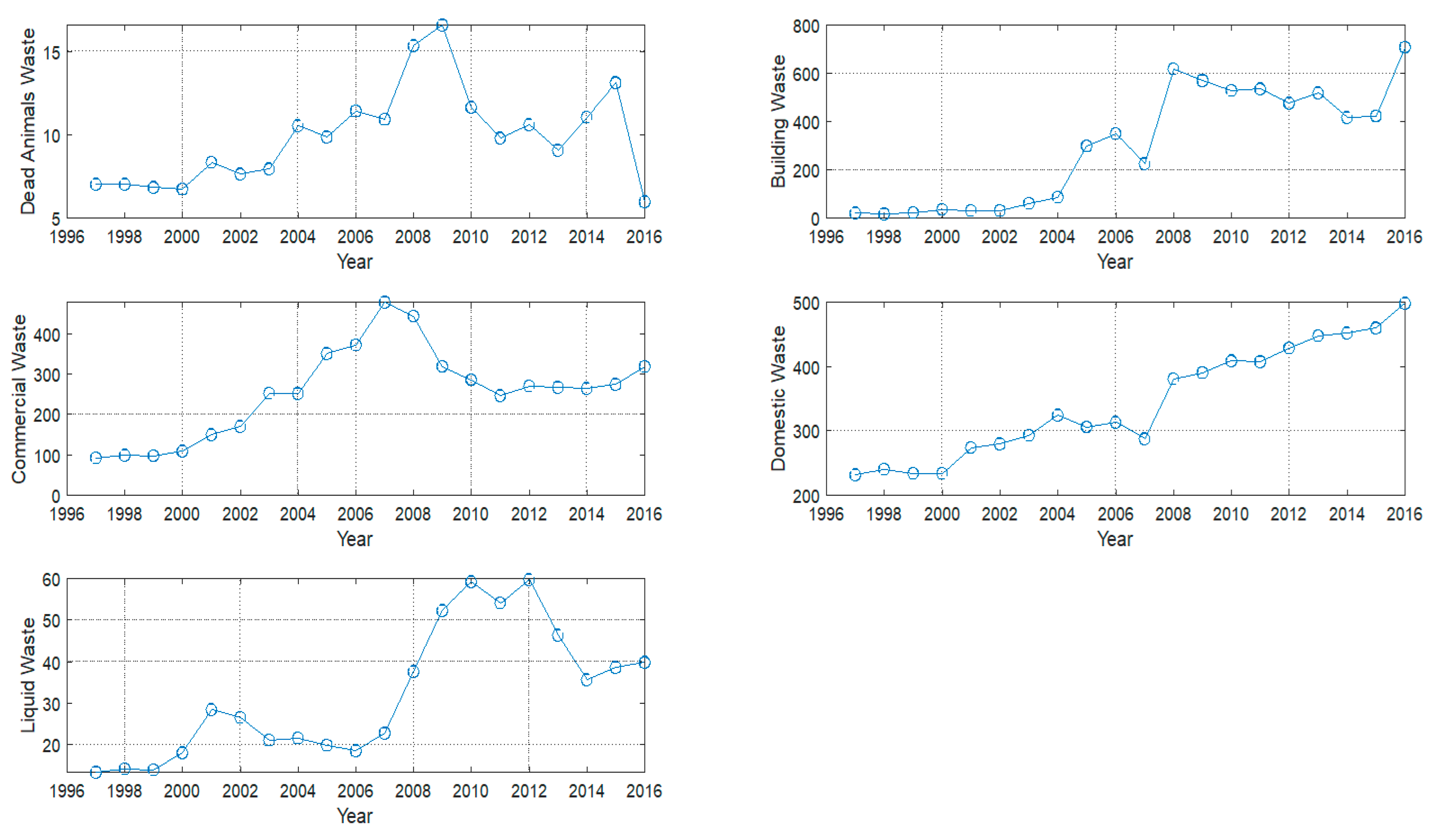
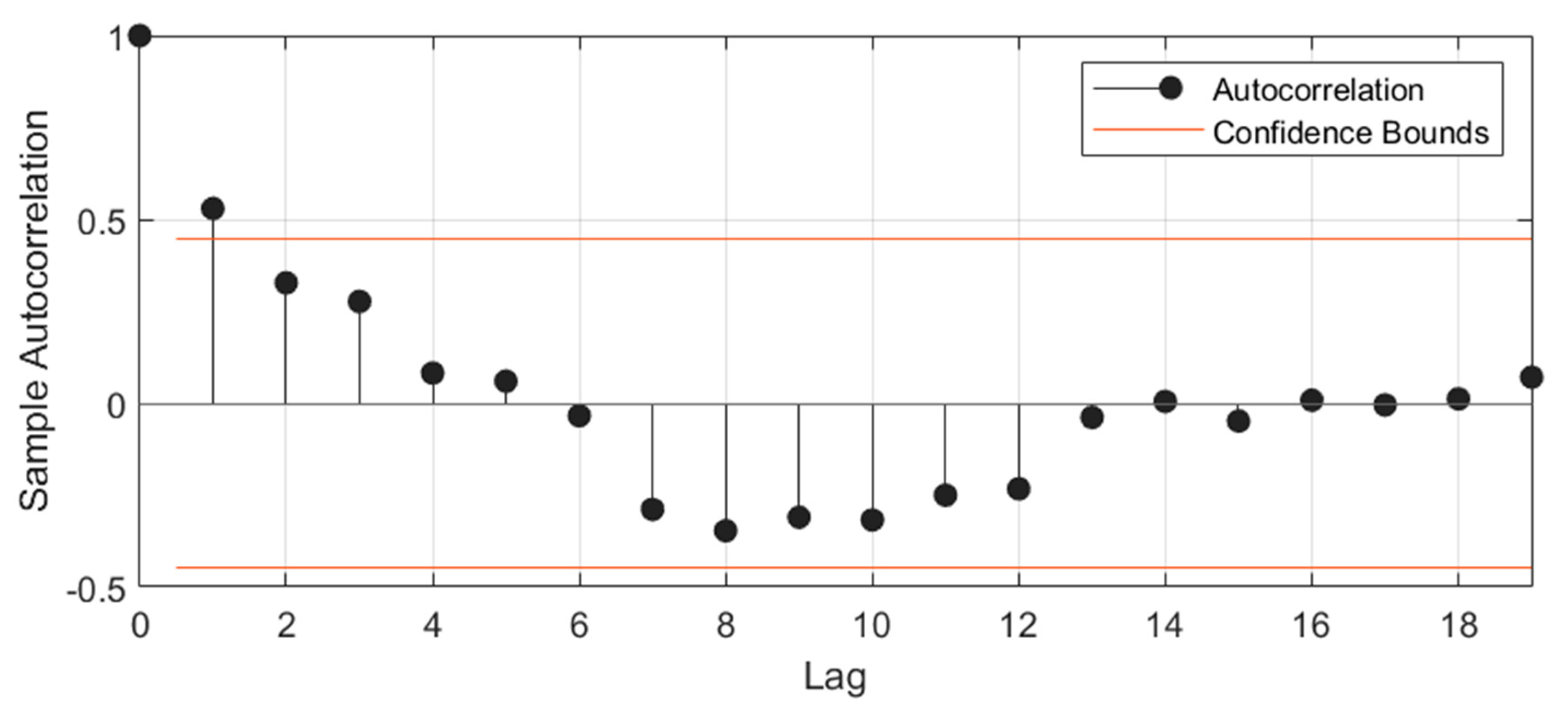
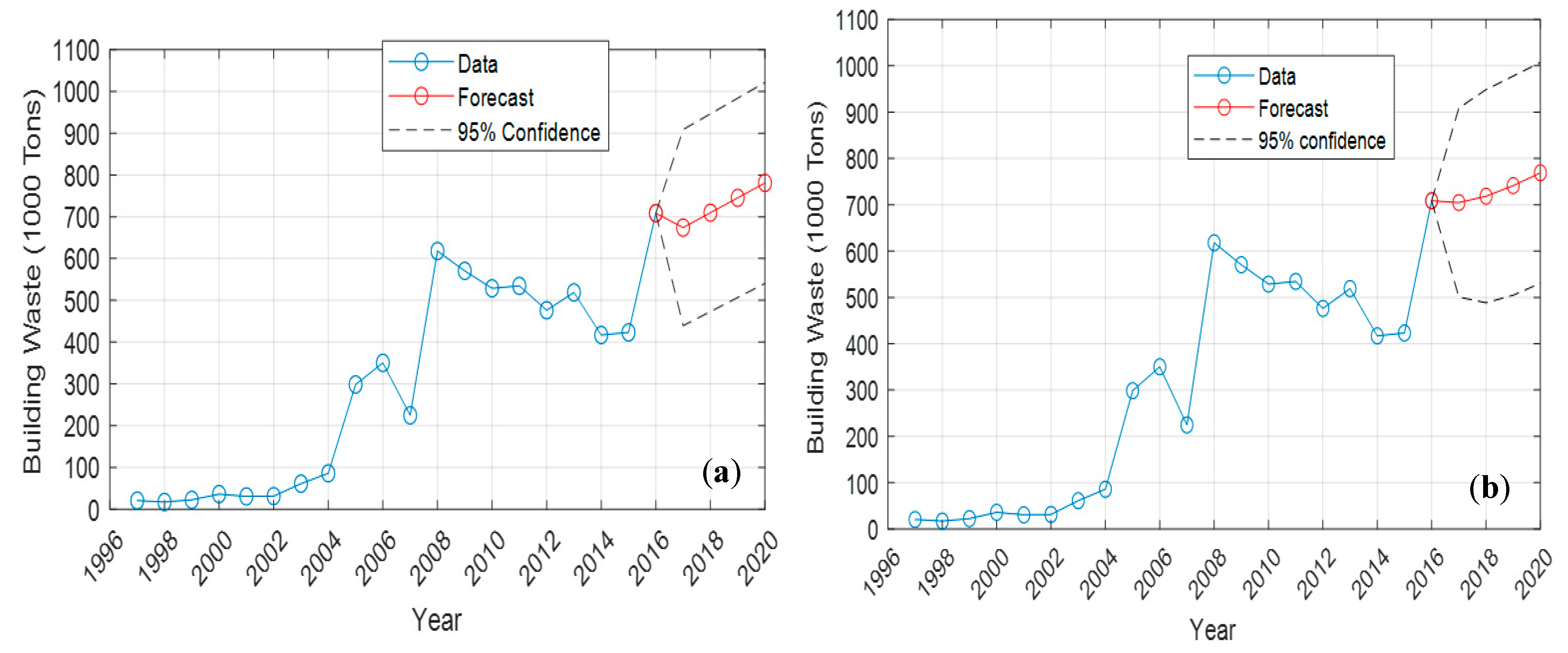
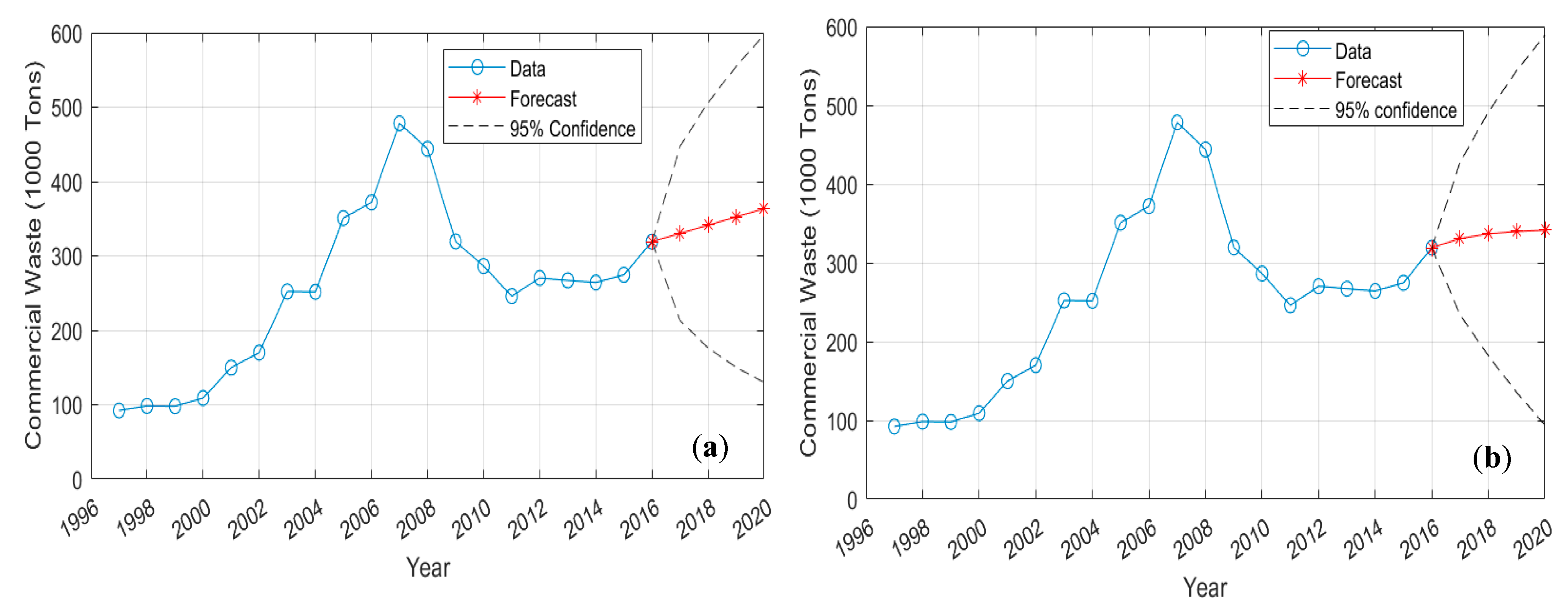
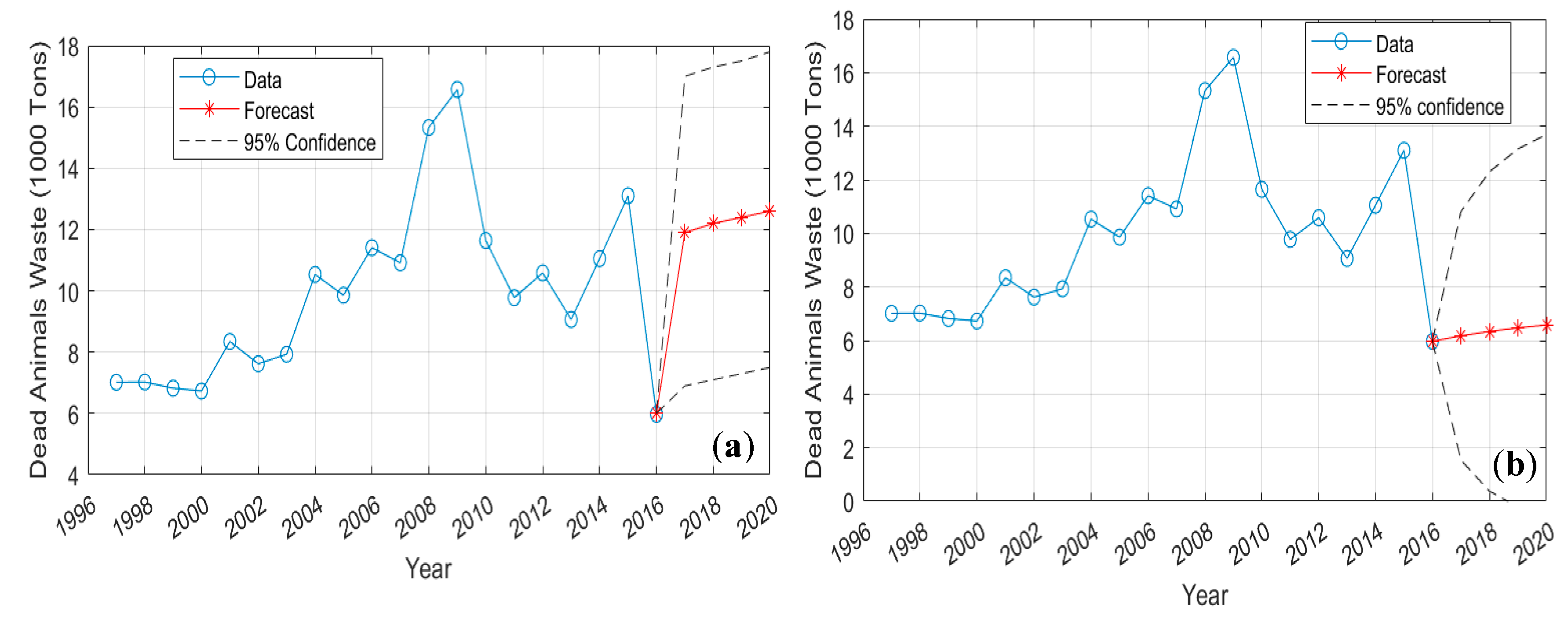

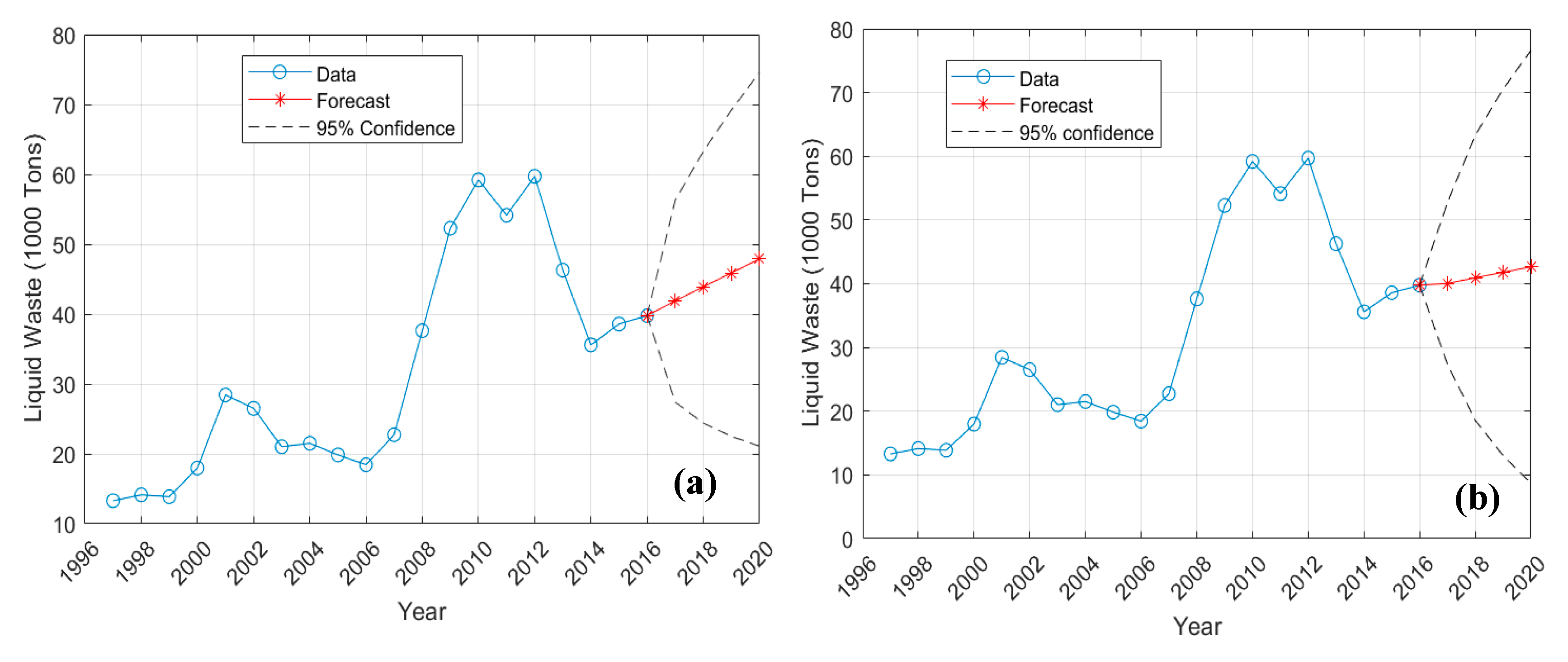
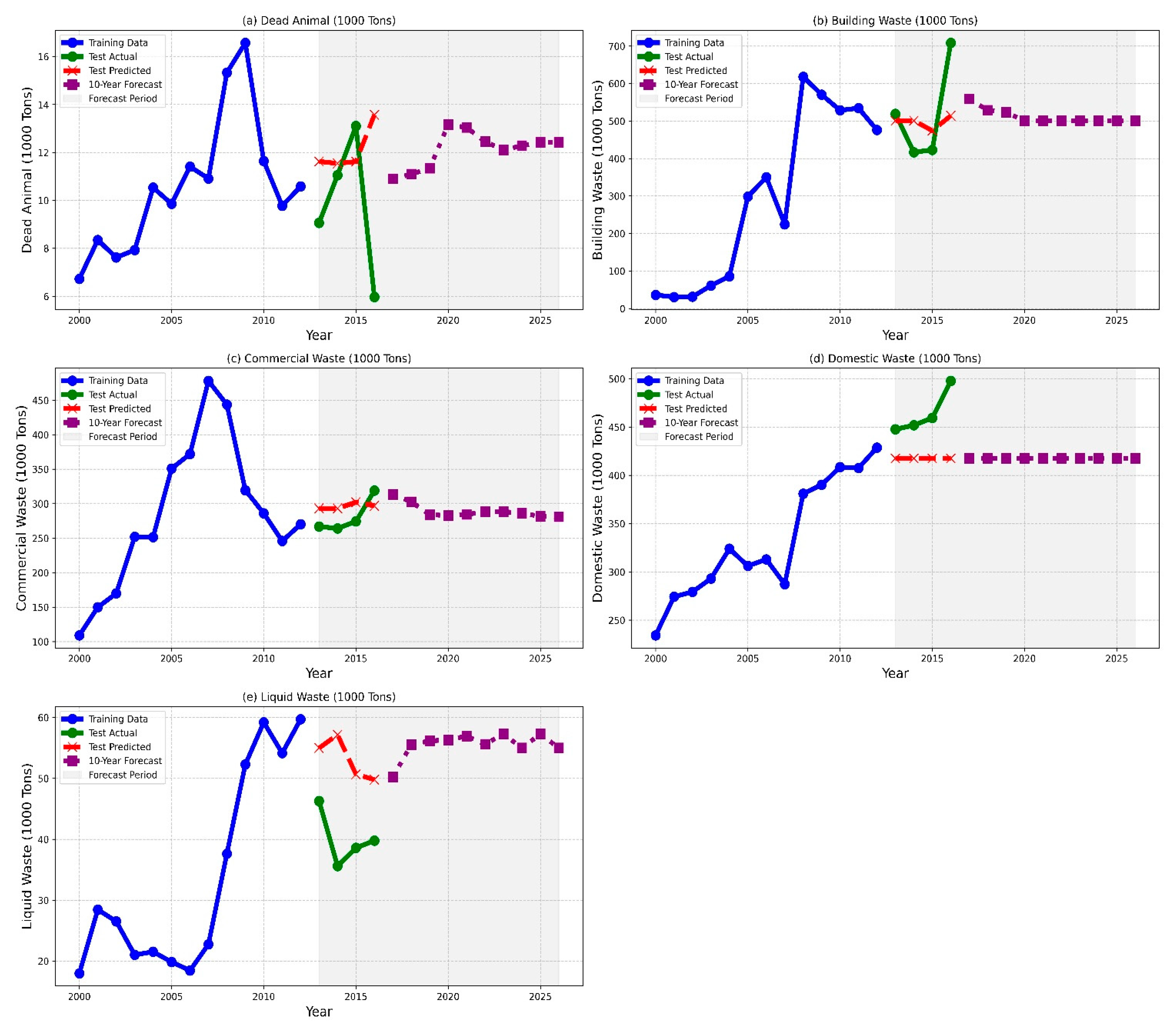
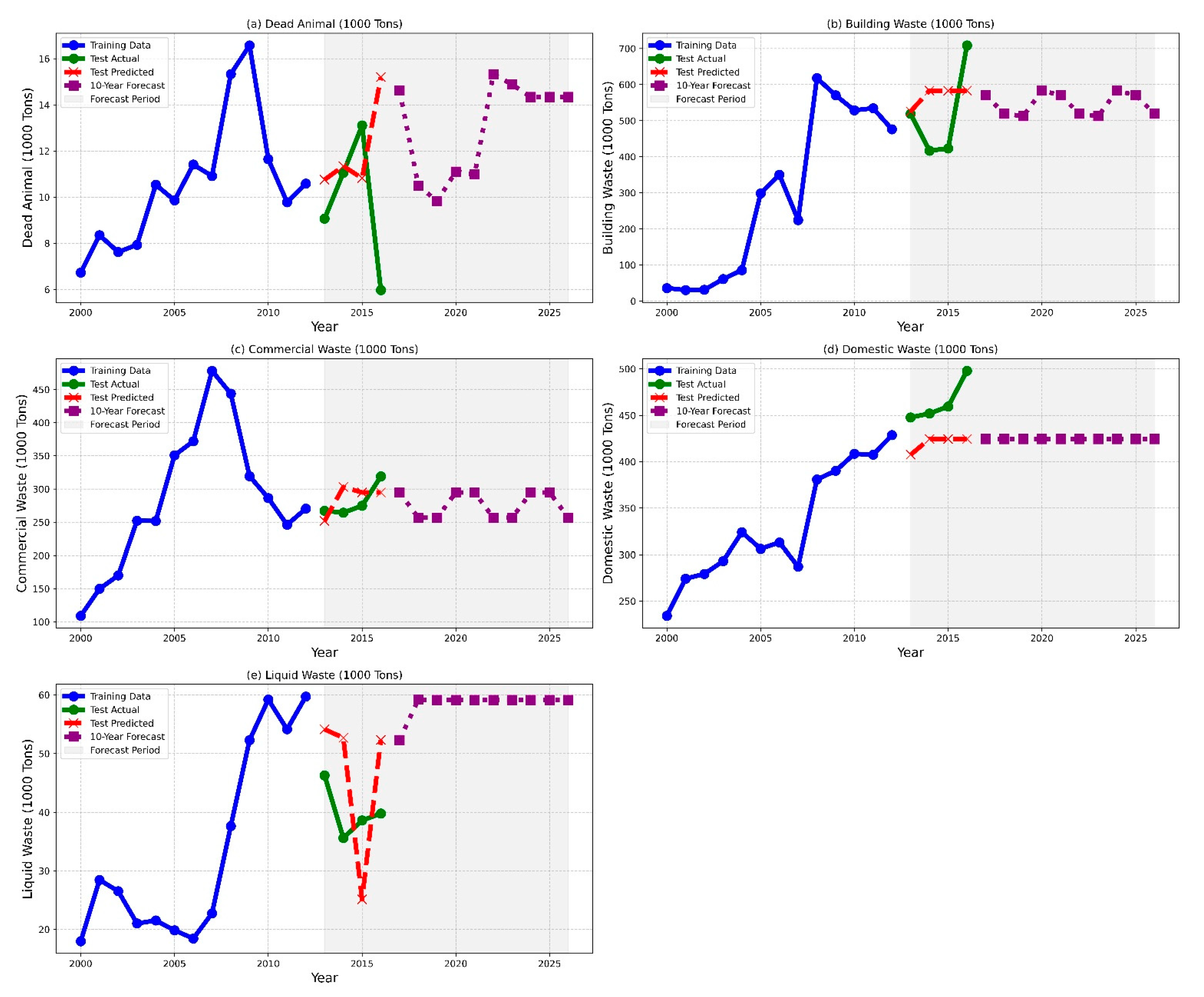
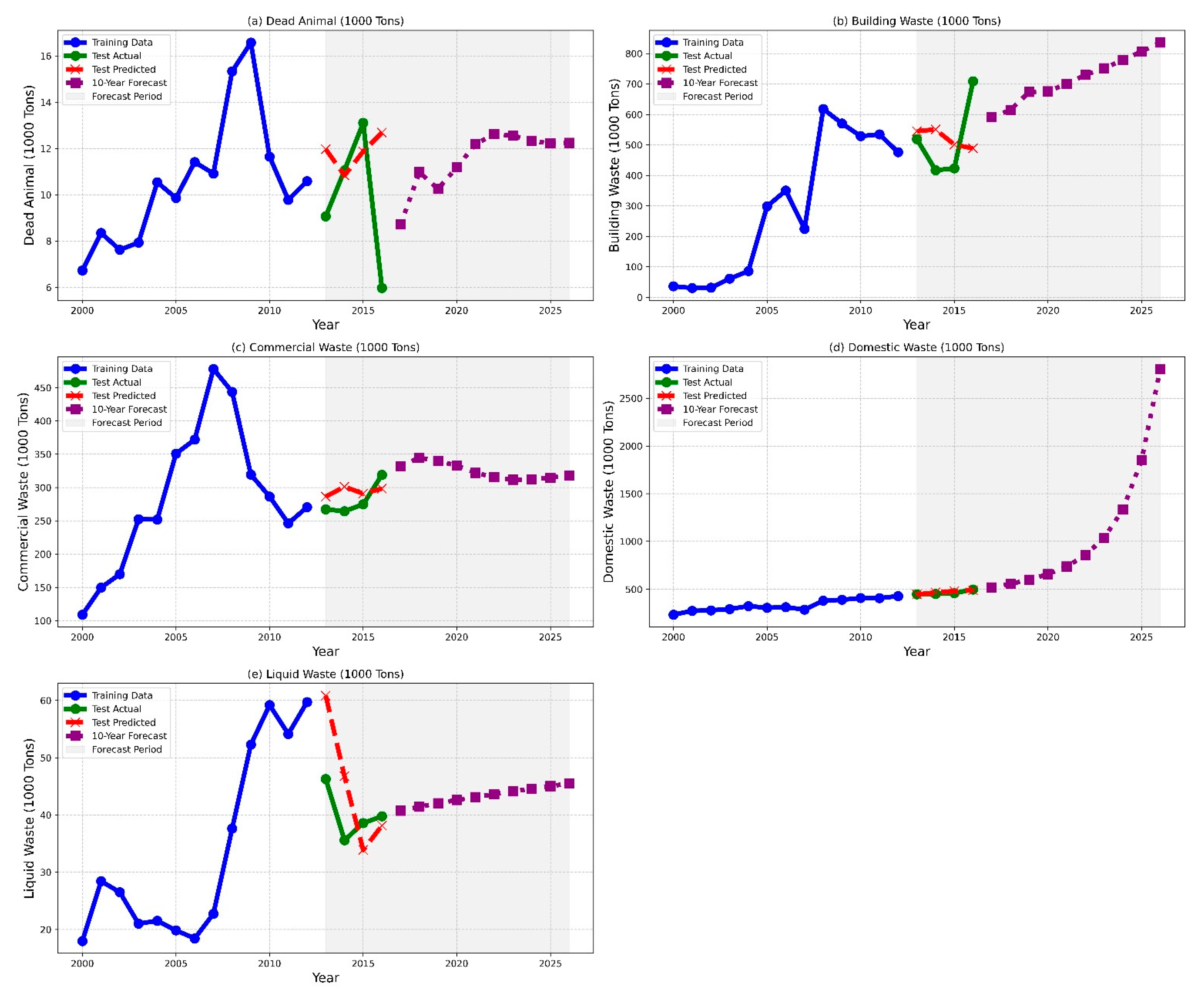
| Stat./Waste | Dead Animal | Building | Commercial | Domestic | Liquid |
|---|---|---|---|---|---|
| Minimum | 6.0 | 17.1 | 92.3 | 231.6 | 13.3 |
| Maximum | 16.6 | 708.6 | 478.2 | 497.9 | 59.7 |
| Mean | 9.9 | 298.7 | 255.7 | 344.5 | 32.0 |
| Standard Dev. | 2.87 | 242.45 | 110.90 | 86.92 | 15.64 |
| Trend | Seasonality | ||
|---|---|---|---|
| None (N) | Additive (A) | Multiplicative (M) | |
| None (N) | (N, N) | (N, A) | (N, M) |
| Additive (A) | (A, N) | (A, A) | (A, M) |
| Additive damped (Ad) | (Ad, N) | (Ad, A) | (Ad, M) |
| ADDITIVE ERROR MODELS | |||
| Trend | Seasonal | ||
| N | A | M | |
| N | |||
| A | |||
| Ad | |||
| MULTIPLICATIVE ERROR MODELS | |||
| Trend | Seasonal | ||
| N | A | M | |
| N | |||
| A | |||
| Ad | |||
| ETS Model | |||||
|---|---|---|---|---|---|
| α | β | γ | RMSE | MASE | |
| Building Waste | 0.126 | 0.001 | 0 | 122 | 1.33 |
| Commercial Waste | 0.998 | 0.001 | 0 | 54.0 | 1.05 |
| Dead Animals Waste | 0.100 | 0.001 | 0 | 3.37 | 2.20 |
| Domestic Waste | 0.750 | 0.001 | 0 | 11.5 | 0.45 |
| Liquid Waste | 0.900 | 0.001 | 0 | 9.47 | 1.81 |
| Waste | Order (p, d, q) | ϕ | θ | c | RMSE | MASE |
|---|---|---|---|---|---|---|
| Building | (1,1,1) | 0.521 | −1 | 15.73 | 104.07 | 0.98 |
| Commercial | (1,1,1) | 0.514 | −0.265 | 0 | 48.43 | 0.88 |
| Dead Animals | (1,1,1) | 0.807 | −1 | 0 | 2.37 | 1.44 |
| Domestic | (1,1,1) | 0.554 | −1 | 6.04 | 20.31 | 0.65 |
| Liquid | (1,1,1) | −0.060 | 0.518 | 0 | 6.53 | 1.14 |
| Waste | ETS | ARIMA | ||||
|---|---|---|---|---|---|---|
| MASE | RMSE | R2 | MASE | RMSE | R2 | |
| Building | 1.33 | 122 | 0.748 | 0.98 | 104.07 | 0.816 |
| Commercial | 1.05 | 54.0 | 0.763 | 0.88 | 48.43 | 0.809 |
| Dead Animals | 2.20 | 3.37 | −0.377 | 1.44 | 2.37 | 0.318 |
| Domestic | 0.45 | 11.5 | 0.982 | 0.65 | 20.31 | 0.945 |
| Liquid | 1.81 | 9.47 | 0.633 | 1.14 | 6.53 | 0.826 |
Disclaimer/Publisher’s Note: The statements, opinions and data contained in all publications are solely those of the individual author(s) and contributor(s) and not of MDPI and/or the editor(s). MDPI and/or the editor(s) disclaim responsibility for any injury to people or property resulting from any ideas, methods, instructions or products referred to in the content. |
© 2025 by the authors. Licensee MDPI, Basel, Switzerland. This article is an open access article distributed under the terms and conditions of the Creative Commons Attribution (CC BY) license (https://creativecommons.org/licenses/by/4.0/).
Share and Cite
Alhathlaul, N.; Lakhouit, A.; Abdalla, G.M.T.; Alghamdi, A.; Shaban, M.; Alshahir, A.; Alshahr, S.; Alali, I.; Mutlaq Alshammari, F. Assessing Waste Management Using Machine Learning Forecasting for Sustainable Development Goal Driven. Sustainability 2025, 17, 8654. https://doi.org/10.3390/su17198654
Alhathlaul N, Lakhouit A, Abdalla GMT, Alghamdi A, Shaban M, Alshahir A, Alshahr S, Alali I, Mutlaq Alshammari F. Assessing Waste Management Using Machine Learning Forecasting for Sustainable Development Goal Driven. Sustainability. 2025; 17(19):8654. https://doi.org/10.3390/su17198654
Chicago/Turabian StyleAlhathlaul, Nada, Abderrahim Lakhouit, Ghassan M. T. Abdalla, Abdulaziz Alghamdi, Mahmoud Shaban, Ahmed Alshahir, Shahr Alshahr, Ibtisam Alali, and Fahad Mutlaq Alshammari. 2025. "Assessing Waste Management Using Machine Learning Forecasting for Sustainable Development Goal Driven" Sustainability 17, no. 19: 8654. https://doi.org/10.3390/su17198654
APA StyleAlhathlaul, N., Lakhouit, A., Abdalla, G. M. T., Alghamdi, A., Shaban, M., Alshahir, A., Alshahr, S., Alali, I., & Mutlaq Alshammari, F. (2025). Assessing Waste Management Using Machine Learning Forecasting for Sustainable Development Goal Driven. Sustainability, 17(19), 8654. https://doi.org/10.3390/su17198654







